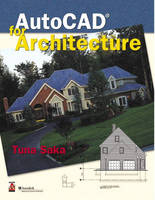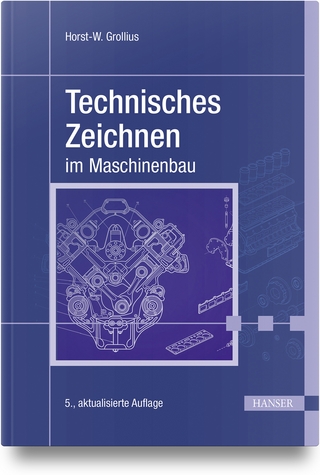
AutoCAD for Architecture
Peachpit Press Publications (Verlag)
978-0-13-091436-1 (ISBN)
- Titel ist leider vergriffen;
keine Neuauflage - Artikel merken
For courses in AutoCAD for Architecture.
This comprehensive text leads students through the basic fundamentals and advanced features of AutoCad for architectural drawing. Step-by-step exercises and applications with tutorials make this a hands-on learning system. It teaches students how to produce architectural working drawings and construction related documents accurately and precisely, along with the skills required to master the 2D drawing commands and procedures.
Tuna Saka is an Associate Professor with the Architectural Technology program, Pennsylvania College of Technology, Williamsport, PA. He received the Associate in Applied Science degree in civil engineering technology from Hudson Valley Community College in 1983 and the Bachelor of Professional Studies and Masters degrees in architecture from the State University of New York at Buffalo in 1986 and 1988, respectively. He is an Autodesk Certified Instructor in the Autodesk Training Center at the Pennsylvania College of Technology and has extensive training in architectural applications of AutoCAD. In addition to teaching, he provides AutoCAD productivity consulting to AEC firms around the globe. Mr. Saka was the recipient of the and the R. Buckminster Fuller scholarship award from the State University of New York at Buffalo and the American Institute of Architects (AIA) foundation scholarship award in 1986 and 1987, respectively. His research interests include the integration of computer technology in architecture and the utilization of computer-aided architectural design in education and practice. He has been teaching AutoCAD at the college level since 1994. He is married and has two children.
Chapters end with Review Questions and Problems.
1. Introduction to AutoCAD 2000i and AutoCAD 2000.
The Architect's Tools of CAD. The Digital Designforce. AutoCAD 2000i and AutoCAD 2000. Launching AutoCAD 2000i. AutoCAD 2000 Startup Feature. AutoCAD 2000 Graphics Window. Resizing a Floating Toolbar. Right-Click Shortcut Menu. Right-Click Customization. MS IntelliMouse Functions. Internet Functions of AutoCAD 2000i. Internet Functions of AutoCAD 2000. What Else Is New in AutoCAD 2000? Useful CAD Web Sites. The Ergonomics of the CAD Workstation.
2. Establishing Drawing Settings.
Organizing and Planning for AutoCAD Drawings. Understanding Drawing Settings. Considerations Before Drawing. Understanding Drawing Units. Understanding Drawing Precision. Angle Format. Angle Direction. Understanding Drawing Scale in Relation to Final Outcome of the Drawing. Introduction to Scale Factor, Sheet Size, and Limits. Scale Factor and Text Height.
3. Establishing Drawing Setup.
Understanding Drawing Setup. Starting a New Drawing. Startup Recommendations. Using Limits to Change Drawing Scale and Paper Size. Opening a Drawing.
4. Establishing Drawing Aids.
Using Drawing Aids. Creating a Grid on the Screen. Establishing a Snap for the Grid. Establishing Grid and Snap Using a Dialog Box. Using System Variables. Establishing Grid and Snap at the Command Line.
5. Drawing Lines.
Drawing Lines with AutoCAD. Accessing Commands. Using the LINE Command. Drawing Lines Using Grid and Snap Spacing. Using Point Entry Systems to Draw Lines. Drawing Lines at an Angle. Using the Ortho Mode. Using the Direct Distance Point Entry System. Creating Openings in Floor Plans. Using the COORDS System Variable. Using Blips in Drawings. Drawing Parallel Lines with the OFFSET Command. Creating Construction Lines. UNDOing and REDOing Commands.
6. Drawing Basic Objects and Shapes.
The Dragging Effect of Objects. Single and Multi-Entity Objects. Drawing Polylines. Drawing Round and Semiround Objects. Drawing Circular Polylines. Drawing Solid Objects. Drawing Rectangles. Drawing Polygons. Drawing Angled and Rounded Corners. Drawing Freehand Lines. Drawing Perfect Curves. Drawing Revision Clouds.
7. Creating Precision Points and Segments.
The Object Snap and AutoTrack Modes. Object Snap. Object Snap Modes. Setting Running Object Snap Modes. AutoTrack. Object Snap Tracking. Establishing Points on Screen. Establishing Points on Objects.
8. Saving and Ending Drawings.
Saving Drawings. Naming Drawings. Drawing File and Summary Information. Exiting AutoCAD.
9. Creating Layers, Linetypes, and Lineweights.
Introduction to Layers. Why Use Layers? Creating Object Properties ByLayer. Naming Layers. Creating Layers. Using the Object Properties Toolbar. Making a Layer Current. Deleting Layers. Establishing Lineweights. Managing Lineweights. Lineweights in Model and Paper Space. Status of Layers. Layer Details Area. Managing Layers. Managing Linetypes. Establishing Linetype Scale. Express Layer Tools.
10. Multiple Design Environment and AutoCAD DesignCenter.
The Multiple Design Environment (MDE). Work Across Drawings. Copying Information Between Drawings. The AutoCAD DesignCenter (ADC). Using the AutoCAD DesignCenter.
11. Displaying Objects and Creating Views.
Getting Close to Your Work. Zoom Options. Zoom Realtime. Pan Realtime. Zoom and Pan Realtime Duo with Right-Click. Using Zoom Transparently. Drawing View Display Accuracy. Creating Drawing Views. Using the -View Command. Using the Aerial View Window.
12. Bask Editing and Modifying.
Introduction to Modifying. Creating a Selection Set for Editing. Erasing Objects. Removing Objects from the Selection Set. Adding Objects to the Selection Set After Removing Objects from the Selection Set. Using the OOPS Command. The PICKAUTO System Variable. Adding All Objects to the Selection Set. Reselecting a Previous Selection Set. Editing Stacked Objects. Using Express Selection Tools. Using the TRIM Command. Using the EXTEND Command. Using the LENGTHEN Command. Using the SCALE Command. Changing the Scale of the Entire Drawing. Using the STRETCH Command. Using the MOVE Command. Using the COPY Command. Using the ROTATE Command. Move Copy Rotate Express Tools. Using the MIRROR Command. Using the ALIGN Command. Using the ARRAY Command. Using the CHANGE Command. Using the SELECT Command. Using the BREAK Command. Creating and Naming Object Groups. Creating a Selection Set Based on Object Type and Properties: Using the QSELECT Command. Editing Polylines.
13. Advanced Editing.
Automatic Editing. Editing Objects with Grips. Object Selection Modes. Using the Properties Window. Using Quick Select with Properties Window. Changing Object Properties Using Match Properities.
14. Creating Text Styles and Placing Text.
Creating Text Styles. Calculating Text Heights. Placing Text on Drawings. Using the DTEXT and TEXT Commands. Using the MTEXT Command. Using the MTEXT Shortcut Menu. Using the QTEXT Command. Editing Text. Express Text Tools.
15. Managing AutoCAD Files and Establishing User Settings.
Using Windows Explorer. Search Paths and File Locations. Creating User Profiles. Using the Options Dialog Box.
16. Drawing Information at Your Fingertips.
Using the Inquiry Toolbar. Finding the Distance Between Two Points. Listing Object Information. Listing Drawing Information. Finding Coordinates for a Point. Finding Areas of Objects and Shapes. Displaying Mass Properties of Shapes.
17. Drawing MultiLines.
Introdction to MultiLines. Advantages of the MultiLine Command. The MultiLine Command. Using the Equation Method to Calculate Offset Values. Multiple Use of the MultiLine Scale Option. Using the Alternate Equation Method to Calculate Offset Values. Using the Direct Distance Offset Method to Calculate Offset Values. Using the MultiLine Properties Dialog Box. Drawing Floor Plans with the MultiLine Command. Developing a Library of MultiLines. Editing MultiLines. Stretching MultiLines. Automatically Editing MultiLines with Grips.
18. Architectural Dimensioning.
Architectural Dimensioning Principles. Using the Dimension Style Manager Dialog Box. Using the Create New Dimension Style Dialog Box. Using the New Dimension Style Dialog Box. Dimensioning Applications. Changing Dimensioning Variables During Dimensioning. Dimensioning Mode. Associative Dimensioning. Dimension Definition Points. Editing Dimensions. Using the WIPEOUT Command to Break One of the Overlapping Extension Lines.
19. Creating Architectural Symbols.
The Role of Architectural Symbols. Blocks. Wblocks. Symbols Library. Size and Scale of Blocks. Calculating Insertion Scale Factors. Color and Linetype of Blocks and Wblocks. Creating Block Definition. Creating Wblocks. Inserting Blocks and Wblocks. Creating Architectural Symbols Library. Nesting Blocks. Multiple Block Insertions. Inserting Blocks Using the Multiple Design Environment. Inserting Blocks Using the AutoCAD DesignCenter. Renaming Blocks. Editing Blocks. Express Block Tools. Purging Objects from a Drawing.
20. Creating Architectural Graphic Patterns.
Creating Hatch Patterns. Using ANSI Hatch Patterns. Using Other Predefined Hatch Patterns. Hatch Visibility. Using the Hatch Command. Direct Hatching. Creating Batt Insulation. Editing Hatch Patterns and Boundaries. Using the Super Hatch Express Tool. Editing Super Hatch Patterns.
21. Assigning Attributes to Symbols.
What Are Attributes? Assigning Attribute Information. Assigning Attributes at the Command Line. Assigning Attributes to Existing Blocks. Inserting Blocks with Attributes Using the Command Line. Inserting Blocks with Attributes Using a Dialog Box. Controlling Attribute Visibility. Suppressing Attribute Prompts. Editing Attributes. Redefining Attributes. Assigning Attributes to Title Blocks. Extracting Attributes.
22. Layouts and Paper Spare.
Model Space, Layouts, and Paper Space. Model Space and Paper Space Viewports. Creating Layouts. Copying Layouts Using AutoCAD DesignCenter. Deleting Layouts. Renaming Layouts. Working with Layout Elements. Page Setup. Creating Tiled Viewports. Creating Rectangular Floating Viewports in Paper Space. Creating Polygonal Floating Viewports in Paper Space. Converting Paper Space Objects to Viewports. Switching Between Model Space and Paper Space. Scaling Viewports. Clipping Existing Viewports. Locking Viewport Scale.
23. Printing and Plotting.
Introduction to Printing and Plotting. Plotting Procedures. Plot Styles. Creating Plot Style Tables. Printing and Plotting from the Model Tab. Printing and Plotting from Paper Space Layouts. Editing Plot Style Tables.
24. Externally Referenced Drawings.
External References. The XREF Command. Attaching External References. Detaching, Reloading, and Unloading External References. Binding External References. The XBIND Command. Clipping External References. Editing Referenced Drawings. Demand Loading and Access to Referenced Drawings. Using XRefs in Paper Space Layouts.
Appendix A. Dimensioning Variables.
Appendix B. AIA (256-Color) Layers.
Index.
| Erscheint lt. Verlag | 3.9.2001 |
|---|---|
| Verlagsort | Berkeley |
| Sprache | englisch |
| Maße | 215 x 279 mm |
| Gewicht | 1730 g |
| Themenwelt | Informatik ► Weitere Themen ► CAD-Programme |
| Technik ► Architektur | |
| ISBN-10 | 0-13-091436-3 / 0130914363 |
| ISBN-13 | 978-0-13-091436-1 / 9780130914361 |
| Zustand | Neuware |
| Haben Sie eine Frage zum Produkt? |
aus dem Bereich


